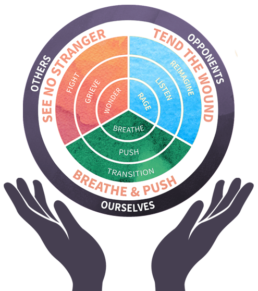3: Fight

“When you love someone, you fight to protect them when they are in harm’s way. If you ‘see no stranger’ and choose to love all people, then you must fight for anyone who is in harm’s way. This was the path of the warrior-sage: the warrior fights, the sage loves.”
“The fight impulse is ancient and fundamental. These ancestors fought with swords and shields, bows and arrows, because they had no choice. They did not have a sophisticated matrix of legal and political avenues to defend civil and human rights, nor international law to mediate conflicts between nations. We have these avenues today. We no longer need literal weapons like the ancestors. But we could still learn from how they marshalled the fight impulse in the battlefield.”
—Valarie Kaur, See No Stranger, Chapter 3
Understanding Fight
A Practice of Love for Others
To fight is to choose to protect those in harm’s way. To fight with revolutionary love is to fight against injustice alongside those most impacted by harm, in a way that preserves our opponents’ humanity as well as our own. When we fight for those outside our immediate circle, our love becomes revolutionary.
- Notice the grief you have been carrying in your body about what’s happening in the world. Now think about the causes of that grief — the institutions and individuals responsible for the suffering and the loss and injustice. Let images flash before your eyes. Slowly, if it’s available to you, let your fists start to clench.
- Notice what it feels like to want to fight back. Notice your fists clench, jaws close, heart beat rise. Your impulse to fight is not something to be ashamed of or to suppress. Honor it. You are alive, and there is something worth fighting for. Then stop, breathe, and ask:
- What will you do with this energy? How will you channel the fight impulse into something that gives life? You have a role to play that no one else can play. You don’t have to know all the answers now. You simply need to allow yourself to feel the power that you have, the abilities that you have, the voice that you have, and invite that deepest wisdom inside of you to guide you into what you need to do now and next.
- Why is fighting necessary in the labor of revolutionary love?
- How can revolutionary love inform how we fight injustice?
- How can the practices of wonder and grieving help us to fight for justice?
- What do we risk when we fight? What do we lose when we choose not to fight?
- What are our own metaphorical swords and shields in the fight for justice?
- Develop these three things: sword, shield, sacred community.
- First, ask yourself: what is your sword, your kirpan? What can you use to fight on behalf of others—your pen, your voice, your art, your pocketbook, your presence? Begin where you are, your home or campus or community, on the front lines or behind the scenes.
- Second, what is your shield, your dhal? Ask yourself: What can you use to protect yourself and others when the fight is dangerous—your camera, legal counsel, a group of allies, public witness? Your safety matters. How will you protect yourself and others? What brings you joy, lifts your spirits, and helps you breathe?
- Finally, who is your sacred community, your sangat? Ask yourself: Who are three people in your life who will fight with and for you and others? If you are not able to imagine three people, start with one or two. What communities can you fight alongside with? Explore community organizations that fight for justice, especially those where women of color are free to lead.
- Discern your role. You have a role to play in any given season of your life and in the movement. Explore the role that you are ready for now in the social change ecosystem, a map developed by activist Deepa Iyer.
- Learn about movements for justice, rooted in love, that everyday people have fought — and won. Follow the visionaries, activists, and artists who invite us into action now. Hear them on podcasts like Baratunde Thurston’s How to Citizen.
- Train to become a strong accomplice, not only an ally. An accomplice is someone who conspires with other marginalized communities to reorder the world. It’s an invitation that comes from Indigenous leaders. Check out these anti-racism support resources. If you are a white person, check out these specific anti-racism sources for accompliceship.

